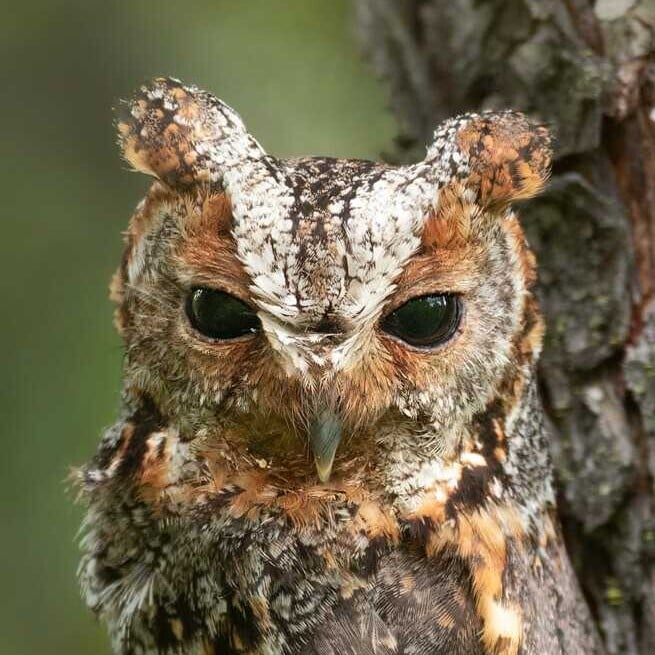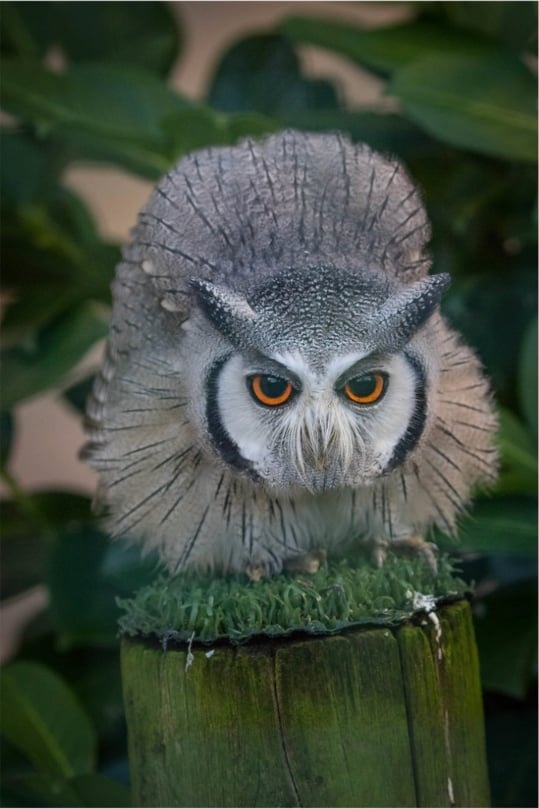Now that I’m not in the middle of having a very crap first day back at work and have come up with a workaround for image uploads, I’ll go more into my visit with this little cutie pie.
The owl encounter started with one member of the staff giving us some solid owl facts that a normal person wouldn’t know. I’d put it on par with the bird banding event I went to, which was probably the best in person educational experience with owls I’ve had, but the banding event covered more work with the birds in addition to basic facts.
We went over basic owl anatomy of the face, ears, eyes, and feathers and looked at pics of all the Pennsylvania owls. There were some hands on things, which were really good. I will go into them more in another post, since it’s about birds no longer in one piece. I have pics of some parts of hawks, condors, and owls that really helped me learn a lot, but I’m sure some of you prefer not to see or hear about that, which is cool and understandable.
What I will say is owl feathers are softer and more delicate than you could imagine! 🥰
We were forbidden from actually touching the live owl and the trainer said he’s not even supposed to really touch it any more than necessary, which did make me sad because I wanted to see its ears and how the leg tendons worked, etc.
We did get to hold a Great Horned Owl wing though, and it was so light and delicate. It was so soft and flexible compared to the hawk wing, and it was much less opaque than I thought. I could easily see my fingers under the feathers and the microscopic barbs that help the feathers keep their shape like Velcro is much gentler on the owl. I couldn’t believe how soft it really was. I’d handled a single wing feather before, but that didn’t give near the same understanding I got from the entire wing. Getting to examine the physical specimens was honestly a little more exciting than holding the owl since I didn’t get to pet it!
After that, it was time to hold the owl itself. The trainer brought it out and we got an introduction to Cedar. They don’t know Cedar’s gender, which surprised me. I thought that kind of generic testing was cheap these days, and it would drive me crazy to not know. I don’t remember how old it was, but I want to say around 4 maybe. Cedar was imprinted by being kept by people too long after they found it on the ground as a baby. I believe it had been cared for by a different rescue before it ended up at the National Aviary, but I was getting too excited to remember all the details.
My girlfriend asked if the gloves were made of kangaroo, which I had asked about in a previous event we went to about the construction of their gloves. They seemed impressed she knew about that. They said they usually don’t mention it to avoid creeping people out, but they just let us handle preserved owl parts on our visit to meet a live owl, so not sure the reason to avoid that interesting fact…
When they handed over the owl, we’d just hold out the glove hand and they tipped him out onto the glove basically. We kept the glove open at first and then closed it around the leather lead you can see in the photo.
My girlfriend just stood there amazed, which was nice she enjoyed it, but didn’t help me take many cool photos! 😆
I moved my arm and wrist all around to try to help get different angles and for me to look at different bits as close as I could without getting too close to make the trainer uncomfortable. He knew what I’d do if he took his eyes off of me!
There was no discernable smell, which surprised me a bit as it eats raw meat only. I did smell the wing specimen when no one was looking too, for science! No smell there either.
The ear openings were not visible whatsoever, which was really why I wanted to have the trainer show me that, but no luck.
Plumicorns are not cone shaped, just maybe 3 to 5 feathers that slant backwards. Was a little surprised; I expected more structure.
Saw the grippy nubs on the bottom of the feet! They look like they give tremendous traction.
Movement is very fluid. As I rolled my wrist, the head stayed mostly straight facing and I couldn’t feel any movement at all. It stayed very still while keeping its focus locked.
Weight is virtually nothing. I hoped it would fly across the room and land on the glove, as it was a private presentation room and had some perches in it. Alas…
You could absolutely feel the grip of the talons though, which shocked me that I could feel the tiny feet through that thick leather! Owl strength is no joke.
I pointed out the zygodactyl toes to my girlfriend, though the little owl didn’t change grips much.
After getting lots of pics and getting a nice all around look, we gave the birdy back and talked a bit more about the National Aviary and then other owls on exhibit. I didn’t check how long it was, but I’d guess a half hour for the whole event.
It wasn’t cheap, but not too bad. It was $70 each, but it did include the admission to the whole aviary, which is something around $25 I believe. The money takes care of the animals and I really loved the hands on with both the owl and the specimens. It’s the closest a normie is going to get to touching an owl without pursuing a long and low paying career in animal work from what I’ve learned so far talking to all the pros. I’d do it again if it was with one of my top owls, but not another Screech. Some type of barn owl or something more rare would be worth paying again, but not another more common owl other than a Tyto since they’re fairly different physically.
I tried to cover everything without getting too much into the specimens, but if you have any other questions about it, feel free to ask. I’ll cover the other owls there in future posts.
I haven’t checked out the shots my girlfriend took yet, so if you want to see if we have any better images of say the feet or eyes, I’ll check.


Thanks for the detailed write up. You got some great pics of that little one!
I wanted to give you guys the closest thing to being there I could! It was tons of fun.